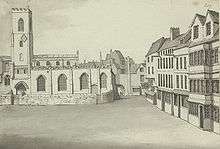St Nicholas' Church, Durham
| St Nicholas' Church, Durham | |
|---|---|
| St Nic's | |
 The church viewed from the marketplace | |
| 54°46′39″N 1°34′31″W / 54.77750°N 1.57528°WCoordinates: 54°46′39″N 1°34′31″W / 54.77750°N 1.57528°W | |
| Location | Durham, County Durham |
| Country | England |
| Denomination | Church of England |
| Churchmanship | Open Evangelical |
| Website |
www |
| History | |
| Dedication | Saint Nicholas |
| Architecture | |
| Status | Civic church |
| Functional status | Active |
| Heritage designation | Grade II |
| Architect(s) | James Pigott Pritchett |
| Completed | 1858 |
| Administration | |
| Parish | St Nicholas Durham |
| Deanery | Deanery of Durham |
| Archdeaconry | Archdeaconry of Durham |
| Diocese | Diocese of Durham |
| Province | Province of York |
| Clergy | |
| Vicar(s) | The Revd Stephen Bellamy |
| NSM(s) |
The Revd Prof Peter Johnson The Revd Colin Patterson The Revd David V. Day |
| Minister(s) | The Revd Lindsey Goodhew |
| Laity | |
| Reader(s) |
Jamie Harrison Andrew Trigger |
St Nicholas' Church, commonly known as St Nic's, is a Church of England place of worship located on Durham marketplace and is the city's civic church. The church stands in the open evangelical tradition of the Church of England, emphasising Bible teaching, the atoning death of Christ, and mission.
History
The current building dates to 1858, and was designed by Darlington architect J. Pritchett. The building was described by the Illustrated London News at the time as "the most beautiful specimen of church architecture in the north of England", but is not now regarded as of particular architectural interest. It is a Grade II listed building.[1]

This building replaced one dating from the early 12th century, whose walls formed part of the city walls and abutted the ancient Clayport Gate (demolished 1791) on one side. Almost all that remains of this church is its font, dating from 1700, and its five bells, dating from 1687 and therefore the oldest ring of bells in the diocese. Though the bells were not rung from the 1970s onwards due to fears for the safety of the tower, ringing resumed in 2000 and the 17th-century bells, along with a sixth added in 1889, are now rung frequently.
George Carey, later Archbishop of Canterbury, was vicar of St Nicholas' from 1975 to 1982. During that time he led a project in which the pews and the majority of the Victorian interior features of the church were removed to allow the church to be used more flexibly for worship and community activities. Carey's book The Church In The Marketplace describes the process and its impact on the life of the parish.[2]
Parish and population

The parish is small (covering only the area around the Market Place, Claypath and The Sands) and is bounded by the parishes of Durham's three other ancient city churches - St Giles', St Oswald's and St Margaret's. Historically the parish was densely populated; however, slum clearance in the 1920s (as well as commercial development of previously residential areas) greatly reduced the population of the parish, and though more recent building has increased this a little, the church draws the majority of its congregation from outside its own parish. It has a large student population, and is classified by the Diocese of Durham as its own locality, meaning that its mission is recognised as distinctly different from those of other city centre churches. The church has a long tradition of evangelicalism, and its patronage has been held by the Church Pastoral Aid Society since the mid-19th century.
Outreach
One notable feature of the reordered church is the Gateway World Shop, which occupies the south-east corner of the church, having its own outside entrance, and sells Fair trade goods. The shop reflects the church's long involvement with the fair trade movement; Richard Adams, founder of Traidcraft, was a member of the church.
St Nics has a long history of supporting overseas mission. The first bishop of Uganda, Alfred Tucker, left his curacy at St Nics to bring Christianity to Uganda. This support is currently expressed by the church's financial support of the Church Mission Society, South American Missionary Society, the Bible Society, Spanish Outreach Ministries and the diocese of Lesotho.
Notable clergy
- The Reverend Stephen Bellamy became the vicar in May 2008, moving from St James', Birkdale, Southport.[3]
- George Carey, later Archbishop of Canterbury, was vicar of St Nicholas' from 1975 to 1982.
- David V. Day, former Principal of St John's College, Durham, was an NSM from 1999 to 2007.
- George Marchant, was vicar of St Nicholas' from 1954 to 1974.
- Alfred Tucker, later Bishop of Eastern Equatorial Africa, served his curacy here in the 1880s.
References
- ↑ Historic England. "Details from image database (110286)". Images of England.
- ↑ Carey, George. The Church in the Market Place. ISBN 0-8192-1562-7.
- ↑ St Nicholas Church - News and Events
External links
| Wikimedia Commons has media related to St Nicholas Church, Durham City. |
- St Nicholas' Church, Durham
- Gateway World Shop at St. Nicholas
- Review of Christmas Day 2007 service by the Ship of Fools' Mystery Worshipper